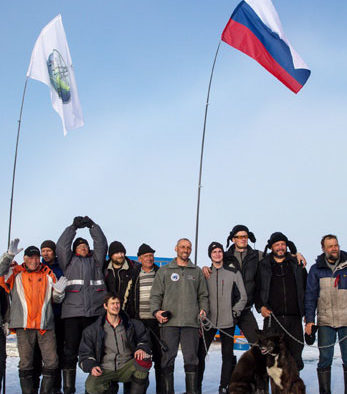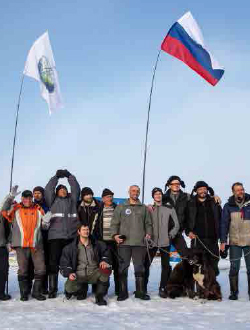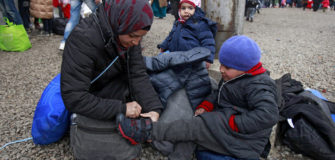What are Russia’s Interests in the Arctic?

 Why Moscow’s primary concerns in the High North are still domestic, and not international
Why Moscow’s primary concerns in the High North are still domestic, and not international
With the outbreak of the Ukraine crisis in 2014, the policy and academic communities of the West accused Russia of militarism and expansionism not only in Eastern Europe but also in the Arctic. They argued that since Russia is economically and technologically weak in the High North, the Kremlin must be placing an emphasis on Russia’s military strength in order to protect the country’s interests in the region.
According to an alarmist or pessimistic school of thought, there is growing competition among the regional players for the Arctic’s natural resources and sea routes. Such competition must inevitably lead to territorial disputes, remilitarization of the High North, and future military conflicts. Naturally, Russia is viewed as a driver of this dangerous process.
To be clear, this is an erroneous representation of both the situation in the Arctic and of Russia’s intentions. Conceptually, Russia’s leadership now realizes that most of the threats and challenges to the Arctic Zone of the Russian Federation (AZRF) originate from inside rather than outside the country. These problems are rooted in a confluence of factors, including the degradation of Soviet-made economic, transport and social infrastructure in the region, the current resource-oriented model of the Russian economy, and the lack of funds and managerial skills in Russia to properly develop the AZRF. It follows that Russia’s current Arctic strategy is of an inward- and not an outward-looking nature. It aims to solve existing domestic problems rather than focus on external expansion. Moreover, in developing the AZRF, Moscow seeks to demonstrate that it is open for international cooperation and to foreign investment and know-how.
As for existing territorial disputes with other coastal states, the Kremlin has repeatedly underlined that all of these disputes should be solved in a peaceful way and on the basis of international law (e.g. the UN Convention on the Law of the Sea, and also the 2008 Ilulissat Declaration). It is noteworthy, on this logic, that Moscow brought its dispute with Denmark and Canada over the underwater Lomonosov ridge, potentially rich in oil and gas, to the UN Commission on the Limits of Continental Shelf. Bref, in the Arctic, Moscow has played strictly by the rules established by the international community.
Some Western analysts expected that in the wake of the Ukraine crisis, Moscow would dramatically increase its military activities and presence in the Arctic, and also accelerate its massive military modernization programmes, thereby provoking military countermeasures from neighbours and destabilizing the regional military balance. Western experts paid particular attention to the fact that, for the first time, the new version of Russia’s military doctrine, issued in December 2014, had assigned to the Russian armed forces the task of protecting Russia’s national interests in the Arctic in peacetime. Moreover, Russia’s new maritime doctrine, issued in July of last year, identified the Arctic – along with the North Atlantic – as a priority area for the Russian navy.
And yet there was no substantive shift, in any practical terms, in Russia’s view of the role of military power in the Arctic. As before, Moscow’s military strategies still have the following three major goals: first, to demonstrate and assure Russia’s sovereignty over the AZRF, including the exclusive economic zone (EEZ) and continental shelf; second, to protect Russia’s economic interests in the High North; and third, to demonstrate that Russia retains its great power status and has world-class military capabilities.
Many foreign analysts tend to forget, or completely misunderstand, that the extent of Russian strategic and conventional forces deployed in the Arctic, and with these the scale of the military modernization programmes, is a function of the fact that Russia inherited the nuclear strategic forces structure of the old Soviet Union. For this reason, the naval bases on the Kola Peninsula in the northwest of Russia are still home to two-thirds of Russia’s strategic nuclear submarines.
This military potential is strictly for purposes of strategic deterrence on a global scale, rather than for ensuring Moscow’s military preponderance in the Arctic region. The largest part of the Northern Fleet’s surface vessels, including the cruiser ‘Peter the Great’ or the aircraft carrier ‘Admiral Kuznetsov,’ is also designated for the projection of Russia’s sea power beyond the Arctic military theatre. Bref, the strategic component of the Russian forces in the High North has little to do with geopolitical rivalry in the Arctic theatre.
The strategic forces’ modernization programmes are limited in scope and aim to replace decommissioned submarines and surface vessels, rather than to increase these forces in terms of quantity and offensive potential. In fact, the total number of strategic submarines and large surface ships continues to decrease by comparison with the levels in the 1980s under the USSR.
As for Russian conventional forces in the High North, their modernization programmes are also quite modest and aim to upgrade these forces, rather than to provide them with additional offensive capabilities or to restore the huge military potential of the Soviet era. The purpose of these projects is twofold: first, to provide the Russian forces undergoing modernization with infrastructure that meets modern requirements; and second, to have this renovated and new infrastructure serve non-military policy objectives, including allowing Russia to implement international agreements on Arctic search and rescue (2011), and in respect of preparedness for fighting potential oil spills in the Arctic (2013). The new radar stations, airfields, and search and rescue centres along the Arctic Ocean’s coastline will be also helpful in terms of further development of the Northern Sea Route and cross-polar flights.
Of course, many serious international experts do not see any particularly alarming trends in Russia’s military behaviour in the Arctic in the aftermath of the Ukraine crisis. The former commander of the US Coast Guard and current US Arctic Ambassador, Admiral Robert Papp, has said: “Everything we have seen them doing so far is lawful, considered and deliberative. So we’ll just continue monitoring it and not overreact to it.” Papp has noted that all countries have a responsibility to be able to provide search and rescue capabilities and navigation assistance in the area, and that Russia seems to be investing in just that.
Military confrontation, then, is not on the agenda. Cooperation is the focus of Arctic politics today. At last year’s international Conference on Global Leadership in the Arctic (“Cooperation, Innovation, Engagement, and Resilience”) – also known as GLACIER – the Obama administration emphasized the importance of cooperation with Moscow on ‘soft security’ issues in the Arctic. As chair of the Arctic Council for the 2015-2017 period, Washington needs support from other Arctic nations in order to successfully implement its agenda on environmental issues, search and rescue, and the well-being of indigenous peoples. It has Moscow’s full support in this regard.
As the recent UN Climate Conference in Paris showed, cooperation between Western countries and Russia is crucial for success in this field. Western capitals and Moscow alike jointly supported the new agreement limiting green-house gas emissions, and pledged to work hard on the ratification of this document by major polluters.
What should a long-term cooperative agenda among Arctic nations include? First and foremost, it should include the lifting of economic sanctions against Russia, and a strategy for attracting investment and technology to Russia’s Arctic economy – including in the extractive and high-tech sectors. Moreover, all Arctic countries should work together to properly implement the recently approved Polar Code for the Northern Sea Route and, potentially, for the Northwest Passage (the code will enter into force in 2017). Work on the preservation of the way of life of Northern indigenous peoples should be advanced and deepened. And, to be sure, in the push to mitigate the impact of climate change in the Arctic, Arctic states should be actively promoting joint scientific research on the Arctic. The Arctic Council will continue to play a key role in all of these dynamics, and its capacity – financially and institutionally – should be strengthened.
Confrontation on the delimitation of maritime spaces and on the definition of the limits of the continental shelf in the Arctic should be avoided at all costs. To this end, confidence-building measures may include the sharing of data on the limits of continental shelf, joint research expeditions, and even joint applications on the division of the Arctic continental shelf to the UN Commission on the Limits of the Continental Shelf. Let us note, with concern, that the Arctic region currently has no confidence- and security-building measures (CSBM) regime – a gap that should be filled with great urgency.
For the foreseeable future, then, Moscow’s strategy in the region will be predictable and pragmatic, rather than aggressive or improvised. In contrast to the widespread stereotype of Russia around the world as a revisionist power or troublemaker in the Arctic, Moscow will continue to pursue a dual-track strategy in the High North: defending Russia’s legitimate economic and political interests, while remaining open to cooperation with foreign partners willing to contribute to exploiting Arctic natural resources, developing sea routes, and solving the numerous socio-economic and environmental problems of the region.
To achieve this, Russia will use peaceful diplomatic, economic and cultural means, and act through international organizations and forums, rather than unilaterally.
Alexander Sergunin and Valery Konyshev are both professors at St. Petersburg State University, Russia.











